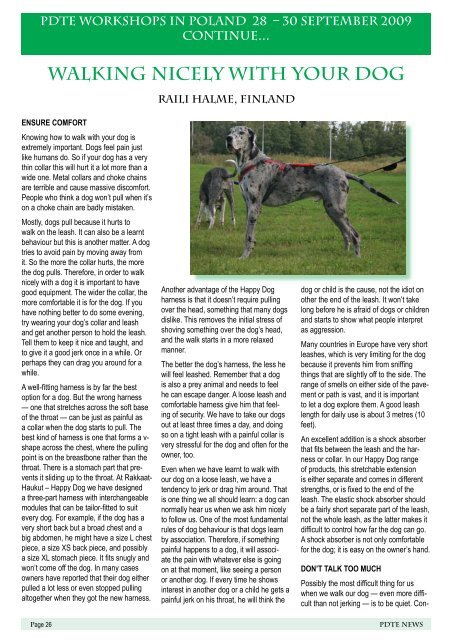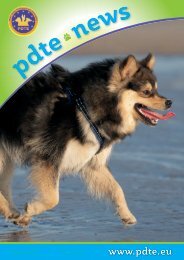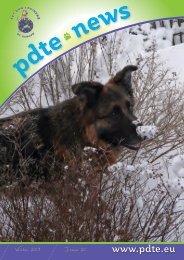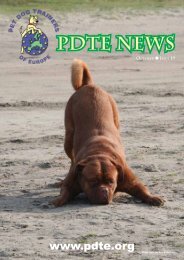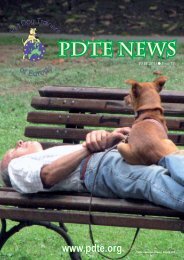You also want an ePaper? Increase the reach of your titles
YUMPU automatically turns print PDFs into web optimized ePapers that Google loves.
<strong>PDTE</strong> Workshops In Poland 28 – 30 September 2009<br />
continue...<br />
WALKING NICELY WITH YOUR DOG<br />
Raili Halme, Finland<br />
ENSURE COMFORT<br />
Knowing how to walk with your dog is<br />
extremely important. Dogs feel pain just<br />
like humans do. So if your dog has a very<br />
thin collar this will hurt it a lot more than a<br />
wide one. Metal collars and choke chains<br />
are terrible and cause massive discomfort.<br />
People who think a dog won’t pull when it’s<br />
on a choke chain are badly mistaken.<br />
Mostly, dogs pull because it hurts to<br />
walk on the leash. It can also be a learnt<br />
behaviour but this is another matter. A dog<br />
tries to avoid pain by moving away from<br />
it. So the more the collar hurts, the more<br />
the dog pulls. Therefore, in order to walk<br />
nicely with a dog it is important to have<br />
good equipment. The wider the collar, the<br />
more comfortable it is for the dog. If you<br />
have nothing better to do some evening,<br />
try wearing your dog’s collar and leash<br />
and get another person to hold the leash.<br />
Tell them to keep it nice and taught, and<br />
to give it a good jerk once in a while. Or<br />
perhaps they can drag you around for a<br />
while.<br />
A well-fitting harness is by far the best<br />
option for a dog. But the wrong harness<br />
— one that stretches across the soft base<br />
of the throat — can be just as painful as<br />
a collar when the dog starts to pull. The<br />
best kind of harness is one that forms a v-<br />
shape across the chest, where the pulling<br />
point is on the breastbone rather than the<br />
throat. There is a stomach part that prevents<br />
it sliding up to the throat. At Rakkaat-<br />
Haukut – Happy Dog we have designed<br />
a three-part harness with interchangeable<br />
modules that can be tailor-fitted to suit<br />
every dog. For example, if the dog has a<br />
very short back but a broad chest and a<br />
big abdomen, he might have a size L chest<br />
piece, a size XS back piece, and possibly<br />
a size XL stomach piece. It fits snugly and<br />
won’t come off the dog. In many cases<br />
owners have reported that their dog either<br />
pulled a lot less or even stopped pulling<br />
altogether when they got the new harness.<br />
Another advantage of the Happy Dog<br />
harness is that it doesn’t require pulling<br />
over the head, something that many dogs<br />
dislike. This removes the initial stress of<br />
shoving something over the dog’s head,<br />
and the walk starts in a more relaxed<br />
manner.<br />
The better the dog’s harness, the less he<br />
will feel leashed. Remember that a dog<br />
is also a prey animal and needs to feel<br />
he can escape danger. A loose leash and<br />
comfortable harness give him that feeling<br />
of security. We have to take our dogs<br />
out at least three times a day, and doing<br />
so on a tight leash with a painful collar is<br />
very stressful for the dog and often for the<br />
owner, too.<br />
Even when we have learnt to walk with<br />
our dog on a loose leash, we have a<br />
tendency to jerk or drag him around. That<br />
is one thing we all should learn: a dog can<br />
normally hear us when we ask him nicely<br />
to follow us. One of the most fundamental<br />
rules of dog behaviour is that dogs learn<br />
by association. Therefore, if something<br />
painful happens to a dog, it will associate<br />
the pain with whatever else is going<br />
on at that moment, like seeing a person<br />
or another dog. If every time he shows<br />
interest in another dog or a child he gets a<br />
painful jerk on his throat, he will think the<br />
dog or child is the cause, not the idiot on<br />
other the end of the leash. It won’t take<br />
long before he is afraid of dogs or children<br />
and starts to show what people interpret<br />
as aggression.<br />
Many countries in Europe have very short<br />
leashes, which is very limiting for the dog<br />
because it prevents him from sniffing<br />
things that are slightly off to the side. The<br />
range of smells on either side of the pavement<br />
or path is vast, and it is important<br />
to let a dog explore them. A good leash<br />
length for daily use is about 3 metres (10<br />
feet).<br />
An excellent addition is a shock absorber<br />
that fits between the leash and the harness<br />
or collar. In our Happy Dog range<br />
of products, this stretchable extension<br />
is either separate and comes in different<br />
strengths, or is fixed to the end of the<br />
leash. The elastic shock absorber should<br />
be a fairly short separate part of the leash,<br />
not the whole leash, as the latter makes it<br />
difficult to control how far the dog can go.<br />
A shock absorber is not only comfortable<br />
for the dog; it is easy on the owner’s hand.<br />
DON’T TALK TOO MUCH<br />
Possibly the most difficult thing for us<br />
when we walk our dog — even more difficult<br />
than not jerking — is to be quiet. Con-<br />
Page 26 <strong>PDTE</strong> NEWS


